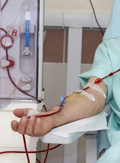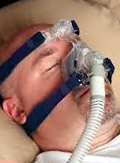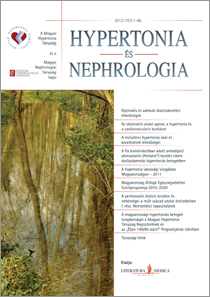The eLitMed.hu medical portal uses computer cookies for convenient operation. Detailed information can be found in the Cookie-policy.
Hypertension and nephrology - 2013;17(01)
Content
[Paradigmal changes in renal replacement therapy. Dialysis and drug therapy of quality in chronic renal patients - Optimal and adequate opportunities of dialysis therapy]
[Researches over the past thirty years, many results have been related to acute and chronic renal failure pathophysiology, clinical characteristics and therapy. Can be more than just the uremic toxins and their characteristics of the regulation of salt and water balance, renal anemia treatment, uremic metabolic disorders, calcium phosphate and lipid metabolism dysfunction. Improve the quality of treatment and reduce mortality and options can be influenced by factors come to, therefore, execution and technique of dialysis therapy. We know the primary concern of the treatment period for reducing mortality. This is best for intermittent treatments increased (4.5-6 hours) treatment will help. Narrow scope is optional for the treatment several times a week treatment, the daily 8-hour long nightly therapy. The mortality of the patient significantly influenced by age, gender, co-morbidities, fluid balance and the CaxPO4. The technical side is the key factor influencing the dialysis fluid purity and membrane properties. The use of high-flux membranes is clearly improving the quality of treatment, the additional benefit of hemodiafiltration therapy, the mortality for those still controversial. For optimal dialysis adequacy, complexity may result in reducing mortality and improving the quality of life in chronic dialysis patients.]
[Obstructive sleep apnea, hypertension and cardiovascular risk]
[Obstructive sleep apnea (OSA) is a surprisingly frequent disease worsening the quality of life of the patients, associated with serious complications, however, largely underdiagnosed and undertreated. OSA, hypertension and other symptoms of the metabolic syndrome are closely and independently correlated. OSA has been substantially emphasized as a new (emerging) cardiometabolic risk factor, not only a risk marker. The severe form of OSA (apnea-hypnea index>20/hour) has been accepted as a component of high cardiovascular risk on the Hungarian Cardiovascular Consensus Conference in 2008. Greater attention both to the identification and to the treatment of blood pressure increase associated with OSA as well as to the detection of OSA in patients with the diagnosis of hypertension has been suggested by the new European OSA and Hypertension Position Papers, because hypertension associated with OSA is frequently resistant and the proper management of OSA and hypertension could decrease the cardiovascular risk in patients followed up either in sleep or in hypertension centres.]
[Causes of and therapeutic opportunities in resistant hypertension]
[Hypertension is an independent cardiovascular risk factor and one of the most frequent diseases in Hungary. In the treatment of hypertensive patients usually more than two drugs are needed for the appropriate blood pressure control. Resistant hypertension (RH) is defined when blood pressure remains above target value despite full doses of antihypertensive medications, which consist of at least three different classes of drugs including a diuretic administered in maximal doses. The frequency of RH can reach 20-30% among hypertensive patients. RH increases the cardiovascular risk because of the lack of target blood pressure. RH is multifactorial and it is important to exclude pseudo-resistant hypertension (e.g. poor compliance, white coat effect). In the background of RH we can find lifestyle factors (e.g. obesity, excessive salt intake, alcoholism, etc.) and a variety of drugs (e.g. non-steroids, corticosteroids, sympathomimetics). In the pathogenesis of RH the increased activity of the sympathetic nervous system has an important role. In the treatment of RH we should manage lifestyle factors and it is important to assess the drugs and diseases (e.g. sleep apnea, chronic kidney disease, diabetes mellitus) which may cause increased blood pressure. It is no exact recommendations for the treatment of RH. Therapy often consists of 4-5 various drugs in combination. An important role has the device therapy of RH in recent years (e.g. stimulation of the carotid baroreceptors and renal denervation) as well.]
[The success of fixed combined amlodipine/atorvastatin (Amlator®) therapy in patients with hypertension and dyslipidemia]
[In total 2606 patients with hypertension and dyslipidemia got combined antihypertensive and antilipid-treatment. The main component of therapy was amlodipine/ atorvastatin fixed combination in different dose variations. The goal of the study was to access optimal target blood pressure and lipid profile. The baseline average blood pressure value was 155.9/90.18 mmHg and it decreased to 132.77/80.04 mmHg during the six months therapy. The lipid profile also changed successfully: the average value of total cholesterol decreased from 5.97 mmol/l to 4.68 mmol/l, LDL cholesteron from 3.45 mmol/l to 2.49 mmol/l and serum triglyceride from 2.1 mmol/l to 1.69 mmol/l. We reached the target values in respect of LDL cholesterol (<2.5 mmol/l) and of triglyceride (<1.7 mmol/l) prescribed in guidelines for subjects with high cardiovascular risk. According to the global cardiovascular risk estimation (European Heart Score) the risk ratio in percent was significantly decreased in each age group, in both genders and in smoking or nonsmoking subjects.]
[Population based study of hypertension in Hungary - 2012 Comprehensive Health Protection Screening Program of Hungary 201-2020]
[Background: The year 2011 saw the continuation of Hungary’s greatest and to date most comprehensive health screening programme started in 2010. The aim of the screening programme established according to the directives of the European Union with the cooperation of more than forty professional organisations is the preservation of the health of the population, the prevention of illnesses and the improvement of the general health status. The programme contributes to the prevention of coronary diseases by passing on knowledge concerning healthy nutrition and guidelines to help the establishment of a health-conscious lifestyle. Partecipants and methods: In the Comprehensive Health Tests Programme of Hungary, the examinations, among them coronary examinations covering the fields of cardiology and hypertension, take place in a specially furnished lorry. The results of the examinations of the people who have presented themselves for the tests (n=19,814) have been evaluated. In the Comprehensive Health Tests Programme of Hungary a total of 10,444 (52.7%) women and 9,370 (47.3%) men were tested at 332 locations. Although the tests were free for all adults, predominantly persons between the ages of 26 and 55 presented themselves. The average age of women was 42 years and that of the men was 40 years. Results: Upon data processing with the help of a query, 28% of the participants reported suffering from hypertension disease. Measurement of the blood pressure was carried out in each case with validated equipment and by qualified medical staff. Based on the data, it can be observed that while among men hypertension tends to occur in larger numbers at a younger age, the tendency is reversed at ages above 45 years, where hypertension is more frequent among women. Among women, the state of normotonia was most frequent up to the age of 45 and stage 1 hypertension became most frequent from the age of 46 onwards. It must be noted, however, that stage 3 hypertension was already present in 1.7% of women of 26 years of age, and the frequency of this category increased to 6% from the age of 46 onwards. The average systolic blood pressure measured among men exceeded the upper limit of the normal range for all age groups. The average systolic blood pressure measured among women was in the normal range up to the age of 55 years and only moved to the pathological range from the age of 56 onwards. The diastolic blood pressure levels were in the normal range for both sexes (with the exception of the age group 46-55 of the men, where it exceeded the upper limit of the normal range by a minimal extent). Among the men, stage 1 hypertension was the most frequent status for all age groups; blood pressures above 140/90 were measured for 39% of the subjects from the age of 18 onwards. The distribution of this did not vary significantly with the increase of age. It must be mentioned here too, that stage 3 hypertension became more frequent with age, and that it was observed in more than 11% of the patients above 56 years of age. The correlation between abdominal circumference, total cholesterol, blood sugar level and the measured blood pressure values was unambiguously ascertainable. In case of simultaneous presence of diabetes and hypertension (women, n=344 and men, n=303), blood pressures above 140/90Hgmm were 2-3 times more frequent for both sexes than without the presence of diabetes. Discussion: Thanks to the vast information obtained through the programme, a comprehensive picture has been drawn up about Hungary’s present health status not only on a regional or cross sectional level, but as it was described in the programme, too. ]
[The beginning and difficulties of peritoneal dialysis at the end of the last century - Part I. International experiences]
[The theoretical background of peritoneal dialysis dates back to the 18th and 19th century. It was in 1923 when the first experimental and clinical experiences were summarised by Ganter from Munich. Of the Hungarian researchers Stephen Rosenak’s name can be mentioned, who was working in this field in Bonn in 1926 and later in London and New York. Obstacles to the spread of this treatment method was the lack of appropriate abdominal catheters, biocompatible solutions and equipment. The intermittent technique of the method was time consuming and, due to the conditions of that time, peritonitis frequently developed. The spread of the method was facilitated by the catheter constructed by Tenchkoff towards the end of the 1960s, the automatization of the treatment and later continuous ambulatory peritoneal dialysis (CAPD) described by Popovich and Moncrief. Further development of the method became possible by the use of the two-litre plastic bags instead of the bottled solution and later a twin-bag system employing the “flush before fill” technique. The occurrence of peritonitis developing during the treatment gradually decreased, in which Stephen I. Vas of Hungarian origin, working in Toronto as a professor of microbiology played an important role by constantly improving and modifying the principles of the therapy. Besides the infection in the abdominal cavity the bioincompatibility of the dialysis fluid presented another problem, which was solved by the use of essential amino acids, icodextrin instead of glucose and bicarbonate instead of lactate. By the turn of the century it became clear that the survival rate of peritoneal dialysis is very similar to that of hemodialysis in the second and third years following the treatment, while in relation to the quality of life it proved to be better. This observation has been proved in numerous clinical studies in the past decade and has been refined with regard to patients’ age, their primary and accompanying diseases. It is my intention to give account of the Hungarian experiences with peritoneal dialysis in the second part.]
1.
Clinical Neuroscience
Is there any difference in mortality rates of atrial fibrillation detected before or after ischemic stroke?2.
Clinical Neuroscience
Factors influencing the level of stigma in Parkinson’s disease in western Turkey3.
Clinical Neuroscience
Neuropathic pain and mood disorders in earthquake survivors with peripheral nerve injuries4.
Journal of Nursing Theory and Practice
[Correlations of Sarcopenia, Frailty, Falls and Social Isolation – A Literature Review in the Light of Swedish Statistics]5.
Clinical Neuroscience
[Comparison of pain intensity measurements among patients with low-back pain]1.
Clinical Neuroscience Proceedings
[A Magyar Stroke Társaság XVIII. Kongresszusa és a Magyar Neuroszonológiai Társaság XV. Konferenciája. Absztraktfüzet]2.
3.
Journal of Nursing Theory and Practice
[A selection of the entries submitted to the literary contest "Honorable mission: the joys and challenges of our profession" ]4.
Journal of Nursing Theory and Practice
[End of Life and Palliative Care of Newborns in the Nursing Context]5.
Journal of Nursing Theory and Practice
[Aspects of Occupational Health Nursing for Incurable Patients ]





